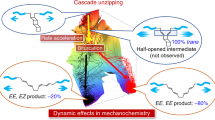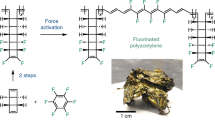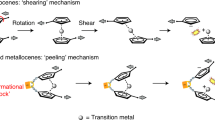Abstract
Mechanical forces along a polymer backbone can be used to bring about remarkable reactivity in embedded mechanically active functional groups, but little attention has been paid to how a given polymer backbone delivers that force to the reactant. Here, single-molecule force spectroscopy was used to directly quantify and compare the forces associated with the ring opening of gem-dibromo and gem-dichlorocyclopropanes affixed along the backbone of cis-polynorbornene and cis-polybutadiene. The critical force for isomerization drops by about one-third in the polynorbornene scaffold relative to polybutadiene. The root of the effect lies in more efficient chemomechanical coupling through the polynorbornene backbone, which acts as a phenomenological lever with greater mechanical advantage than polybutadiene. The experimental results are supported computationally and provide the foundation for a new strategy by which to engineer mechanochemical reactivity.
This is a preview of subscription content, access via your institution
Access options
Subscribe to this journal
Receive 12 print issues and online access
$259.00 per year
only $21.58 per issue
Buy this article
- Purchase on Springer Link
- Instant access to full article PDF
Prices may be subject to local taxes which are calculated during checkout




Similar content being viewed by others
References
Hickenboth, C. R. et al. Biasing reaction pathways with mechanical force. Nature 446, 423–427 (2007).
Lenhardt, J. M. et al. Reactive cross-talk between adjacent tension-trapped transition states. J. Am. Chem. Soc. 113, 3222–3225 (2011).
Lenhardt, J. M. et al. Trapping a diradical transition state by mechanochemical polymer extension. Science 329, 1057–1060 (2010).
Brantley, J. N., Wiggins, K. M. & Bielawaski, C. W. Unclicking the click: mechanically facilitated 1,3-dipolar cycloreversions. Science 333, 1606–1609 (2011).
Wiggins, K. M. & Bielawaski, C. W. A mechanochemical approach to deracemization. Angew. Chem. Int. Ed. 51, 1640–1643 (2012).
Piermattei, A., Karthikeyan, S. & Sijbesma, R. P. Activating catalysts with mechanical force. Nature Chem. 1, 133–137 (2009).
Davis, D. A. et al. Force-induced activation of covalent bonds in mechanoresponsive polymeric materials. Nature 459, 68–72 (2009).
Chen, Y. et al. Mechanically induced chemiluminescence from polymers incorporating a 1,2-dioxetane unit in the main chain. Nature Chem. 4, 559–562 (2012).
Black, A. L., Lenhardt, J. M. & Craig, S. L. From molecular mechanochemistry to stress-responsive materials. J. Mater. Chem. 21, 1655–1663 (2011).
Black, A. L., Orlicki, J. A. & Craig, S. L. Mechanochemically triggered bond formation in solid-state polymers. J. Mater. Chem. 21, 8460–8465 (2011).
Caruso, M. M. et al. Mechanically-induced chemical changes in polymeric materials. Chem. Rev. 109, 5755–5798 (2009).
Lenhardt, J. M. et al. Characterizing the mechanochemically active domains in gem-dihalocyclopropanated polybutadiene under compression and tension. J. Mater. Chem. 21, 8454–8459 (2011).
Tian, Y. & Boulatov, R. Quantum-chemical validation of the local assumption of chemomechanics for a unimolecular reaction. ChemPhysChem 13, 2277–2281 (2012).
Ribas-Arino, J., Shiga, M. & Marx, D. Mechanochemical transduction of externally applied forces to mechanophores. J. Am. Chem. Soc. 132, 10609–10614 (2010).
Kryger, M. J., Munaretto, A. M. & Moore, J. S. Structure–mechanochemical activity relationships for cyclobutane mechanophores. J. Am. Chem. Soc. 133, 18992–18998 (2011).
Lenhardt, J. M., Black, A. L. & Craig, S. L. gem-Dichlorocyclopropanes as abundant and efficient mechanophores in polybutadiene copolymers under mechanical stress. J. Am. Chem. Soc. 131, 10818–10819 (2009).
Brantley, J. N., Konda, S. S. M., Makarov, D. E. & Bielawaski, C. W. Regiochemical effects on molecular stability: a mechanochemical evaluation of 1,4- and 1,5-disubstituted triazoles. J. Am. Chem. Soc. 134, 9882–9885 (2012).
Yang, Q-Z. et al. A molecular force probe. Nature Nanotech. 4, 302–306 (2009).
Sheiko, S. S. et al. Adsorption-induced scission of carbon–carbon bonds. Nature 440, 191–194 (2006).
Ong, M. T., Leiding, J., Tao, H., Virshup, A. & Martinez, T. J. First principles dynamics and minimum energy pathways for mechanochemical ring opening of cyclobutene. J. Am. Chem. Soc. 131, 6377–6379 (2009).
Ribas-Arino J., Shiga M. & Marx D. Understanding covalent mechanochemistry. Angew. Chem. Int. Ed. 48, 4190–4193 (2009).
Konda, S. S. M., Brantley, J. N., Bielawaski, C. W. & Makarov, D. E. Chemical reactions modulated by mechanical stress: extended Bell theory. J. Chem. Phys. 135, 164103 (2011).
Garcia-Manyes, S., Liang, J., Szoszkiewicz, R., Kuo, T-L. & Fernandez, J. M. Force-activated reactivity switch in a bimolecular chemical reaction. Nature Chem. 1, 236–242 (2009).
Alegre-Cebollada, J., Kosuri, P., Rivas-Pardo, J. A. & Fernandez, J. M. Direct observation of disulfide isomerization in a single protein. Nature Chem. 3, 882–887 (2011).
Garcia-Manyes, S., Kuo, T-L. & Fernandez, J. M. Contrasting the individual reactive pathways in protein unfolding and disulfide bond reduction observed within a single protein. J. Am. Chem. Soc. 133, 3104–3113 (2011).
Kersey, F. R., Yount, W. C. & Craig, S. L. Single-molecule force spectroscopy of bimolecular reactions: system homology in the mechanical activation of ligand substitution reactions. J. Am. Chem. Soc. 128, 3886–3887 (2006).
Wu, D., Lenhardt, J. M., Black, A. L., Akhremitchev, B. B. & Craig, S. L. Molecular stress relief through a force-induced irreversible extension in polymer contour length. J. Am. Chem. Soc. 132, 15936–15938 (2010).
Akbulatov, S., Tian, Y. & Boulatov, R. Force-reactivity property of a single monomer is sufficient to predict the micromechanical behavior of its polymer. J. Am. Chem. Soc. 134, 7620–7623 (2012).
Dopieralski, P. et al. On the role of polymer chains in transducing external mechanical forces to benzocyclobutene mechanophores. J. Mater. Chem. 21, 8309–8316 (2011).
Ribas-Arino, J., Shiga, M. & Marx, D. Mechanochemical transduction of externally applied forces to mechanophores. J. Am. Chem. Soc. 132, 10609–10614 (2010).
Klukovich, H. M. et al. Tension trapping of carbonyl ylides facilitated by a change in polymer backbone. J. Am. Chem. Soc. 134, 9577–9580 (2012).
Oberhauser, A. F., Marszalek, P. E., Erickson, H. P. & Fernandez, J. M. Polysaccharide elasticity governed by chair–boat transitions of the glucopyranose ring. Nature 393, 181–185 (1998).
Evans, E. & Ritchie, K. Dynamic strength of molecular adhesion bonds. Biophys. J. 72, 1541–1555 (1997).
Evans, E. Probing the relation between force lifetime and chemistry in single molecular bonds. Annu. Rev. Biophys. Biomol. Struct. 30, 105–128 (2001).
Ray, C., Brown, J. R. & Akhremitchev, B. B. Correction of systematic errors in single-molecule force spectroscopy with polymeric tethers by atomic force microscopy. J. Phys. Chem. B 111, 1963–1974 (2007).
Dobrynin, A. V., Carrillo, J-M. Y. & Rubinstein, M. Chains are more flexible under tension. Macromolecules 43, 9181–9190 (2010).
Duffey, D. C., Minyard, J. P. & Lane, R. H. Thermal rearrangement of 1,1-dibromo-cis-2,3-dimethylcyclopropane. J. Org. Chem. 31, 3865–3867 (1966).
Faza, O. N., Lopez, C. S., Alvarez, R. & de Lera, A. R. Solvolytic ring opening reactions of cyclopropyl bromides. An assessment of the Woodward–Hoffmann–dePuy rule. J. Org. Chem. 69, 9002–9010 (2004).
Boulatov, R. Reaction dynamics in the formidable gap. Pure Appl. Chem. 83, 25–41 (2011).
Hummer, G. & Szabo, A. Free energy profiles from single-molecule pulling experiments. Proc. Natl Acad. Sci. USA 107, 21441–21445 (2010).
Hummer, G. & Szabo, A. Kinetics from nonequilibrium single-molecule pulling experiments. Biophys. J. 85, 5–15 (2003).
Dudko, O. K., Hummer, G. & Szabo, A. Intrinsic rates and activation free energies from single-molecule pulling experiments. Phys. Rev. Lett. 96, 108101 (2006).
Wiita, A. P., Ainavarapu, S. R. K., Huang, H. H. & Fernandez, J. M. Force-dependent chemical kinetics of disulfide bond reduction observed with single-molecule techniques. Proc. Natl Acad. Sci. USA 103, 7222–7227 (2006).
Huang, Z. et al. Method to derive restoring forces of strained molecules from kinetic measurments. J. Am. Chem. Soc. 131, 1407–1409 (2009).
Dopieralski, P., Ribas-Arino, J. & Marx, D. Force-transformed free-energy surfaces and trajectory-shooting simulations reveal the mechano-stereochemistry of cyclopropane ring-opening reactions. Angew. Chem. Int. Ed. 50, 7105–7108 (2011).
Beyer, M. K. The mechanical strength of a covalent bond calculated by density functional theory. J. Chem. Phys. 112, 7307–7312 (2000).
Acknowledgements
This material is based on work supported by the US Army Research Laboratory and the Army Research Office (grant no. W911NF-07-1-0409) and the National Science Foundation (DMR-1122483). The authors thank B. Akhremitchev for providing the original force–extension modelling code.
Author information
Authors and Affiliations
Contributions
H.M.K and S.L.C. conceived and designed the experiments. H.M.K. and J.M.L. performed the synthesis. T.B.K. collected the AFM data. H.M.K., T.B.K. and S.L.C. analysed the data. Z.S.K. contributed modelling data. H.M.K. and S.L.C. wrote the manuscript.
Corresponding author
Ethics declarations
Competing interests
The authors declare no competing financial interests.
Supplementary information
Supplementary information
Supplementary information (PDF 1829 kb)
Rights and permissions
About this article
Cite this article
Klukovich, H., Kouznetsova, T., Kean, Z. et al. A backbone lever-arm effect enhances polymer mechanochemistry. Nature Chem 5, 110–114 (2013). https://doi.org/10.1038/nchem.1540
Received:
Accepted:
Published:
Issue Date:
DOI: https://doi.org/10.1038/nchem.1540
This article is cited by
-
Editing of polymer backbones
Nature Reviews Chemistry (2023)
-
The many flavours of mechanochemistry and its plausible conceptual underpinnings
Nature Reviews Chemistry (2021)
-
Distal conformational locks on ferrocene mechanophores guide reaction pathways for increased mechanochemical reactivity
Nature Chemistry (2021)
-
Single-molecule observation of mechanical isomerization of spirothiopyran and subsequent Click addition
Nano Research (2021)
-
The cascade unzipping of ladderane reveals dynamic effects in mechanochemistry
Nature Chemistry (2020)



